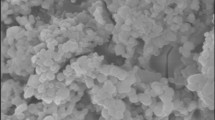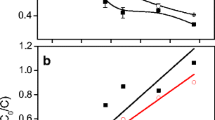Abstract
Nanoscale zerovalent iron (nZVI)-mediated degradation of 1,1,1-trichloro-2,2-bis(p-chlorophenyl)ethane (DDT) was investigated in a spiked soil under different conditions (iron sources, iron dosage, soil moisture, temperature, and soil types) and DDT-contaminated field. The degradation efficiency of p,p′-DDT by nZVI and nZVI coated with sodium oleate (SO-nZVI) was much higher than that by nZVI coated with polyimide (PI-nZVI). The rapid degradation of p,p′-DDT by nZVI only occurred in flooded soil. The degradation half-life of p,p′-DDT decreased significantly from 58.3 to 27.6 h with nZVI dosage from 0.5 to 2.0 % and from 46.5 to 32.0 h with temperature from 15 to 35 °C. The degradation efficiency of p,p′-DDT by nZVI differed in Jinhua (JH), Jiaxing (JX), Xiaoshan (XS), Huajiachi (HJC), and Heilongjiang (HLJ) soils. A good correlation was found between the degradation half-life of p,p′-DDT and multiple soil properties. The probable nZVI-mediated degradation pathway of p,p′-DDT in soil was proposed as DDT → DDD/DDE → DDNS → DDOH based on the metabolites identified by GC-MS. The in situ degradation efficiency of residual DDTs in a contaminated field was profoundly enhanced by the addition of nZVI as compared to the control. It is concluded that nZVI might be an efficient agent for the remediation of DDT-contaminated soil under anaerobic environment.





Similar content being viewed by others
References
Chen X, Yao XY, Yu CN, Su XM, Shen CF, Chen C, Huang RL, Xu XH (2014) Hydrodechlorination of polychlorinated biphenyls in contaminated soil from an e-waste recycling area, using nanoscale zerovalent iron and Pd/Fe bimetallic nanoparticles. Environ Sci Pollut Res 21(7):5201–5210
Eganhouse RP, Pontolillo J, Leiker TJ (2000) Diagenetic fate of organic contaminants on the Palos Verdes Shelf, California. Mar Chem 70(4):289–315
Eggen T, Majcherczyk A (2006) Effects of zero-valent iron (Fe-0) and temperature on the transformation of DDT and its metabolites in lake sediment. Chemosphere 62(7):1116–1125
El-Temsah YS, Joner EJ (2013) Effects of nano-sized zero-valent iron (nZVI) on DDT degradation in soil and its toxicity to collembolan and ostracods. Chemosphere 92(1):131–137
El-Temsah YS, Oughton DH, Joner EJ (2013) Effects of nano-sized zero-valent iron on DDT degradation and residual toxicity in soil: a column experiment. Plant Soil 368(1–2):189–200
Gao F, Jia JY, Wang XM (2008) Occurrence and ordination of dichlorodiphenyltrichloroethane and hexachlorocyclohexane in agricultural soils from Guangzhou, China. Arch Environ Contam Toxicol 54(2):155–166
Gomes HI, Dias-Ferreira C, Ottosen LM, Ribeiro AB (2014) Electrodialytic remediation of polychlorinated biphenyls contaminated soil with iron nanoparticles and two different surfactants. J Colloid Interface Sci 433:189–195
Gomes HI, Dias-Ferreira C, Ottosen LM, Ribeiro AB (2015) Electroremediation of PCB contaminated soil combined with iron nanoparticles: effect of the soil type. Chemosphere 131:157–163
Guo Y, Yu HY, Zeng EY (2009) Occurrence, source diagnosis, and biological effect assessment of DDT and its metabolites in various environmental compartments of the Pearl River Delta, South China: a review. Environ Pollut 157(6):1753–1763
He N, Li P, Zhou Y, Ren W, Fan S, Verkhozina VA (2009) Catalytic dechlorination of polychlorinated biphenyls in soil by palladium-iron bimetallic catalyst. J Hazard Mater 164(1):126–132
He F, Zhao D, Paul C (2010) Field assessment of carboxymethyl cellulose stabilized iron nanoparticles for in situ destruction of chlorinated solvents in source zones. Water Res 44(7):2360–2370
Hu WY, Huang B, Zhao YC, Sun WX, Gu ZQ (2014) Distribution, sources and potential risk of HCH and DDT in soils from a typical alluvial plain of the Yangtze River Delta region, China. Environ Geochem Health 36(3):345–358
Huang HJ, Liu SM, Kuo CE (2001) Anaerobic biodegradation of DDT residues (DDT, DDD, and DDE) in estuarine sediment. J Environ Sci Health B 36(3):273–288
Karn B, Kuiken T, Otto M (2009) Nanotechnology and in situ remediation: a review of the benefits and potential risks. Environ Health Perspect 117(12):1823–1831
Katsenovich YP, Miralles-Wilhelm FR (2009) Evaluation of nanoscale zerovalent iron particles for trichloroethene degradation in clayey soils. Sci Total Environ 407(18):4986–4993
Kim SC, Yang JE, Ok YS, Skousen J, Kim DG, Joo JH (2010) Accelerated metolachlor degradation in soil by zerovalent iron and compost amendments. Bull Environ Contam Toxicol 84(4):459–464
Li FB, Li XM, Zhou SG, Zhuang L, Cao F, Huang DY, Xu W, Liu TX, Feng CH (2010) Enhanced reductive dechlorination of DDT in an anaerobic system of dissimilatory iron-reducing bacteria and iron oxide. Environ Pollut 158(5):1733–1740
Liang L, Yang W, Guan X, Li J, Xu Z, Wu J, Huang Y, Zhang X (2013) Kinetics and mechanisms of pH-dependent Se (IV) removal by zero valent iron. Water Res 47(15):5846–5855
Lin C, Chang TC (2007) Photosensitized reduction of DDT using visible light: the intermediates and pathways of dechlorination. Chemosphere 66(6):1003–1011
Liu HF, Qian TW, Zhao DY (2013) Reductive immobilization of perrhenate in soil and groundwater using starch-stabilized ZVI nanoparticles. Chin Sci Bull 58(2):275–281
Long YY, Zhang C, Du Y, Tao XQ, Shen DS (2014) Enhanced reductive dechlorination of polychlorinated biphenyl-contaminated soil by in-vessel anaerobic composting with zero-valent iron. Environ Sci Pollut Res 21(6):4783–4792
Lundin L, Molto J, Fullana A (2013) Low temperature thermal degradation of PCDD/Fs in soil using nanosized particles of zerovalent iron and CaO. Chemosphere 91(6):740–744
Noubactep C (2008) A critical review on the process of contaminant removal in Fe0-H20 systems. Environ Technol 29(8):909–920
Olson MR, Blotevogel J, Borch T, Petersen MA, Royer RA, Sale TC (2014) Long-term potential of in situ chemical reduction for treatment of polychlorinated biphenyls in soils. Chemosphere 114:144–149
Satapanajaru T, Anurakpongsatorn P, Songsasen A, Boparai H, Park J (2006) Using low-cost iron byproducts from automotive manufacturing to remediate DDT. Water Air Soil Pollut 175(1–4):361–374
Satapanajaru T, Anurakpongsatorn P, Pengthamkeerati P, Boparai H (2008) Remediation of atrazine-contaminated soil and water by nano zerovalent iron. Water Air Soil Pollut 192(1–4):349–359
Sayles GD, You G, Wang M, Kupferle M (1997) DDT, DDD, and DDE dechlorination by zero-valent iron. Environ Sci Technol 31(12):3448–3454
Sheng GD, Shao XY, Li YM, Li JF, Dong HP, Cheng W, Gao X, Huang YY (2014) Enhanced removal of uranium (VI) by nanoscale zerovalent iron supported on na-bentonite and an investigation of mechanism. J Phys Chem A 118(16):2952–2958
Sheu YT, Chen SC, Chien CC, Chen CC, Kao CM (2015) Application of a long-lasting colloidal substrate with pH and hydrogen sulfide control capabilities to remediate TCE-contaminated groundwater. J Hazard Mater 284:222–232
Singh R, Manickam N, Mudiam MKR, Murthy RC, Misra V (2013) An integrated (nano-bio) technique for degradation of γ-HCH contaminated soil. J Hazard Mater 258–259:35–41
Sriprom P, Neramittagapong S, Lin C, Wantala K, Neramittagapong A, Grisdanurak N (2015) Optimizing chemical oxygen demand removal from synthesized wastewater containing lignin by catalytic wet-air oxidation over CuO/Al2O3 catalysts. J Air Waste Manag Assoc 65(7):828–836
Tang ML, Zhao MR, Zhou SS, Chen K, Zhang CL, Liu WP (2014) Assessing the underlying breast cancer risk of Chinese females contributed by dietary intake of residual DDT from agricultural soils. Environ Int 73:208–215
USEPA (2009) US Environmental Protection Agency, Washington, DC, USA. About pesticides. Available at www.epa.gov/pesticides/about/index.htm
Varanasi P, Fullana A, Sidhu S (2007) Remediation of PCB contaminated soils using iron nano-particles. Chemosphere 66(6):1031–1038
Wang ZY, Huang WL, Peng PA, Fennell DE (2010) Rapid transformation of 1,2,3,4-TCDD by Pd/Fe catalysts. Chemosphere 78(2):147–151
Wu YX, Wu ZH, Huang XF, Simonnot MO, Zhang T, Qiu RL (2015) Synergistical enhancement by Ni2+ and Tween-80 of nanoscale zerovalent iron dechlorination of 2,2′,5,5′-tetrachlorinated biphenyl in aqueous solution. Environ Sci Pollut Res 22(1):555–564
Yang SC, Lei M, Chen TB, Li XY, Liang Q, Ma C (2010) Application of zerovalent iron (Fe-0) to enhance degradation of HCHs and DDX in soil from a former organochlorine pesticides manufacturing plant. Chemosphere 79(7):727–732
Zhang WX (2003) Nanoscale iron particles for environmental remediation: an overview. J Nanoparticle Res 5(3–4):323–332
Zhang PF, Tao X, Li ZH, Bowman RS (2002) Enhanced perchloroethylene reduction in column systems using surfactant-modified zeolite/zero-valent iron pellets. Environ Sci Technol 36(16):3597–3603
Zhang M, He F, Zhao D, Hao X (2011) Degradation of soil-sorbed trichloroethylene by stabilized zero valent iron nanoparticles: effects of sorption, surfactants, and natural organic matter. Water Res 45(7):2401–2414
Zhang Z, Hu S, Baig SA, Tang J, Xu XH (2012) Catalytic dechlorination of Aroclor 1242 by Ni/Fe bimetallic nanoparticles. J Colloid Interface Sci 385:160–165
Acknowledgments
This work was supported by the National High Technology R&D Program of China (No. 2012AA06A204), the Zhejiang Provincial Natural Science Foundation (No. LZ13D010001), the Specialized Research Fund for the Doctoral Program of Higher Education (No. 20120101110073), and the National Nature Science Foundation of China (No. 21477112).
Author information
Authors and Affiliations
Corresponding authors
Additional information
Responsible editor: Santiago V. Luis
Rights and permissions
About this article
Cite this article
Han, Y., Shi, N., Wang, H. et al. Nanoscale zerovalent iron-mediated degradation of DDT in soil. Environ Sci Pollut Res 23, 6253–6263 (2016). https://doi.org/10.1007/s11356-015-5850-3
Received:
Accepted:
Published:
Issue Date:
DOI: https://doi.org/10.1007/s11356-015-5850-3




